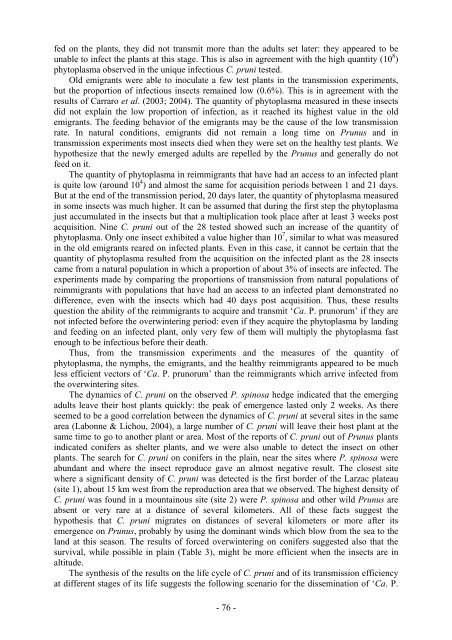Ecole Nationale Supérieure Agronomique de Montpellier ... - CIAM
Ecole Nationale Supérieure Agronomique de Montpellier ... - CIAM
Ecole Nationale Supérieure Agronomique de Montpellier ... - CIAM
Create successful ePaper yourself
Turn your PDF publications into a flip-book with our unique Google optimized e-Paper software.
fed on the plants, they did not transmit more than the adults set later: they appeared to be<br />
unable to infect the plants at this stage. This is also in agreement with the high quantity (10 8 )<br />
phytoplasma observed in the unique infectious C. pruni tested.<br />
Old emigrants were able to inoculate a few test plants in the transmission experiments,<br />
but the proportion of infectious insects remained low (0.6%). This is in agreement with the<br />
results of Carraro et al. (2003; 2004). The quantity of phytoplasma measured in these insects<br />
did not explain the low proportion of infection, as it reached its highest value in the old<br />
emigrants. The feeding behavior of the emigrants may be the cause of the low transmission<br />
rate. In natural conditions, emigrants did not remain a long time on Prunus and in<br />
transmission experiments most insects died when they were set on the healthy test plants. We<br />
hypothesize that the newly emerged adults are repelled by the Prunus and generally do not<br />
feed on it.<br />
The quantity of phytoplasma in reimmigrants that have had an access to an infected plant<br />
is quite low (around 10 4 ) and almost the same for acquisition periods between 1 and 21 days.<br />
But at the end of the transmission period, 20 days later, the quantity of phytoplasma measured<br />
in some insects was much higher. It can be assumed that during the first step the phytoplasma<br />
just accumulated in the insects but that a multiplication took place after at least 3 weeks post<br />
acquisition. Nine C. pruni out of the 28 tested showed such an increase of the quantity of<br />
phytoplasma. Only one insect exhibited a value higher than 10 7 , similar to what was measured<br />
in the old emigrants reared on infected plants. Even in this case, it cannot be certain that the<br />
quantity of phytoplasma resulted from the acquisition on the infected plant as the 28 insects<br />
came from a natural population in which a proportion of about 3% of insects are infected. The<br />
experiments ma<strong>de</strong> by comparing the proportions of transmission from natural populations of<br />
reimmigrants with populations that have had an access to an infected plant <strong>de</strong>monstrated no<br />
difference, even with the insects which had 40 days post acquisition. Thus, these results<br />
question the ability of the reimmigrants to acquire and transmit ‘Ca. P. prunorum’ if they are<br />
not infected before the overwintering period: even if they acquire the phytoplasma by landing<br />
and feeding on an infected plant, only very few of them will multiply the phytoplasma fast<br />
enough to be infectious before their <strong>de</strong>ath.<br />
Thus, from the transmission experiments and the measures of the quantity of<br />
phytoplasma, the nymphs, the emigrants, and the healthy reimmigrants appeared to be much<br />
less efficient vectors of ‘Ca. P. prunorum’ than the reimmigrants which arrive infected from<br />
the overwintering sites.<br />
The dynamics of C. pruni on the observed P. spinosa hedge indicated that the emerging<br />
adults leave their host plants quickly: the peak of emergence lasted only 2 weeks. As there<br />
seemed to be a good correlation between the dynamics of C. pruni at several sites in the same<br />
area (Labonne & Lichou, 2004), a large number of C. pruni will leave their host plant at the<br />
same time to go to another plant or area. Most of the reports of C. pruni out of Prunus plants<br />
indicated conifers as shelter plants, and we were also unable to <strong>de</strong>tect the insect on other<br />
plants. The search for C. pruni on conifers in the plain, near the sites where P. spinosa were<br />
abundant and where the insect reproduce gave an almost negative result. The closest site<br />
where a significant <strong>de</strong>nsity of C. pruni was <strong>de</strong>tected is the first bor<strong>de</strong>r of the Larzac plateau<br />
(site 1), about 15 km west from the reproduction area that we observed. The highest <strong>de</strong>nsity of<br />
C. pruni was found in a mountainous site (site 2) were P. spinosa and other wild Prunus are<br />
absent or very rare at a distance of several kilometers. All of these facts suggest the<br />
hypothesis that C. pruni migrates on distances of several kilometers or more after its<br />
emergence on Prunus, probably by using the dominant winds which blow from the sea to the<br />
land at this season. The results of forced overwintering on conifers suggested also that the<br />
survival, while possible in plain (Table 3), might be more efficient when the insects are in<br />
altitu<strong>de</strong>.<br />
The synthesis of the results on the life cycle of C. pruni and of its transmission efficiency<br />
at different stages of its life suggests the following scenario for the dissemination of ‘Ca. P.<br />
- 76 -



